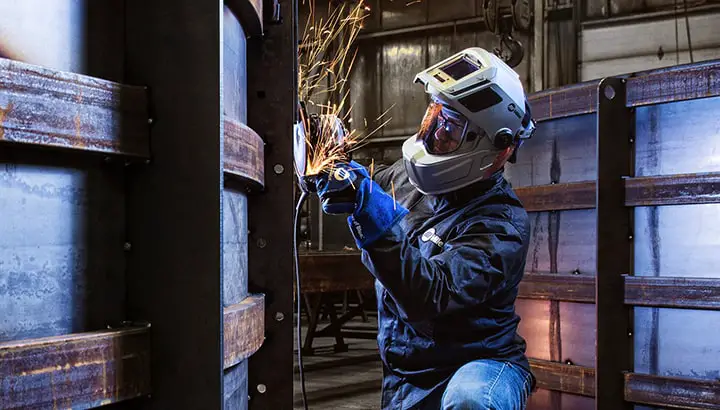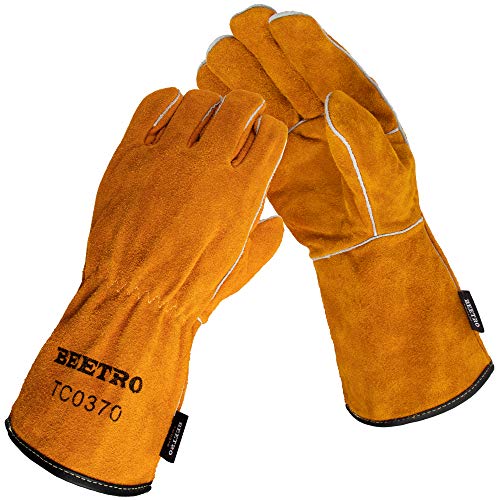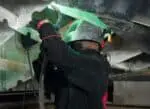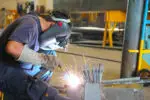It’s the most basic thing to say, but a welder requires a flame-resistant and fire-retardant PPE for protection whether welding indoors or outdoors.
Flames, molten metal, and sparks are the immediate dangers that have to be taken care of. And leather is one of the best materials that can protect a welder from sustaining burn injuries.
Here’s how things get more interesting: there are different types of leather. And you should pick the type depending upon the type of welding involved.
The four best leather materials ideal for welding are cowhide leather, elk leather, Pigskin leather, and deerskin leather.
Keep reading to find out which leather is the best for stick welding, TIG welding, and MIG welding.
Can you wear leather when welding – 3 Advantages of wearing leather for welding
Leather is an absolutely stunning material that protects not only from sparks and flames but also from heat. Hence, it’s an ideal material for welding. Welding boots and welding gloves made out of pure leather are essential parts of a welder’s safety PPE.
There are 3 undeniable benefits of wearing leather over other fabrics for welding. Let’s have a look.
#1. Leather is puncture-resistant and abrasion-resistant
Leather’s fire resistance is quite high. It self-extinguishes if sparks get in contact directly. As a result, it withstands the test of time too.
The durability and abrasion resistance makes leather (top grain leather, mostly) last for years without damage.
Having said that, since pure leather is animal skin, you have got to be careful. Cleaning the leather surface is going to be the key factor that’ll decide how long it will last.
#2. Leather keeps heat from burning the skin at high temperatures
Since temperatures soar really high when welding, it’s not just sparks that can burn the skin, heat can cause equal damage (even more).
That’s why it’s important that the clothing you’re wearing isn’t just fire-resistant, but also heat-resistant.
Heat cannot penetrate the leather. That’s probably one of the most compelling reasons that most experienced welders prefer wearing leather jackets while welding.
#3. Leather protects from sparks and flame
Flailing sparks can easily penetrate through clothing that’s not flame-resistant, and the welder can sustain burn injuries.
Pure leather is strong and highly resistant to fire. Hence, a spark or two spattering directly on the leather surface won’t create holes.
Naturally, it will not let sparks touch your skin directly. Hence, you won’t sustain burn injuries when wearing leather boots and leather jackets.
4 types of leather that are best for welding
Different types of welding have different constraints. The heat involved and temperatures vary significantly. This is why you should buy leather that offers the best protection according to the type of welding being done.
Have a look at the four best types of leather and pick your options wisely.
1.) Cowhide – Cowhide leather is best suited for stick welding. Other than the practical constraints like sparks and spatter, stick welding also comes with an added disadvantage of making the surroundings dirty.
Since cowhide leather is extremely dirt-resistant alongside being fire-retardant and durable, it’s one of the best options when sticking welding metals. Besides, it offers the strongest protection from flame and sparks too.
2.) Elkskin – Elkskin leather is another very good option for stick welding. It resists heat, sparks, and flames like nothing else.
Besides, elkskin leather is also non-bulky and thin. Hence, you will be comfortable since a jacket made of Elkskin leather will also keep you cool.
3.) Deerskin – Deerskin leather is ideal for TIG welding. Since sparks and spatter aren’t that much of a concern in TIG welding, there’s actually no need to wear cowhide leather. A medium to heavy-cut deerskin leather is enough to offer protection during TIG welding.
4.) Pigskin – Pigskin leather is most suitable for MIG welding. It’s highly resistant to abrasion and somewhat lighter too. Hence, it’s a very good option for welding jackets.
Are leather shoes good for welding – 2 Best Leather welding boots you should buy
Boots are quite an essential part of a welder’s safety ensemble. As long as they can offer insulation and wick away sweat, they are considered as leading contenders for protection.
Leather, out of the many materials, is one of the best options to make welding boots. Why? Well, explore the reasons in the pointers listed below.
1.) Leather welding boots protect from molten metal alongside sparks.
2.) They can essentially wick moisture and once you break into your leather boots, they’re a long-term companion.
3.) Since leather welding boots prevent heat, you can wear them easily when the temperature is relentlessly high.
Let’s now have a look at a couple of welding boots you can buy.
1.) Timberland PRO Men’s MetGuard Steel-Toe Welding Boots
- Ankle-high boot with EverGuard waterproof leather upper featuring Goodyear welt construction with Kevlar thread
- Lace front with waterproof MetGuard flap
- Comfort-inspired closed-cell PU footbed with durable cushioning
- Meets ASTM safety standards. Steel Safety Toe-Meets I/75 and C/75 impact and compression ASTM F2412-11 and F2413-11 safety standards.
- Abrasion, slip, and oil-resistant rubber outsole
Prices pulled from the Amazon Product Advertising API on:
Product prices and availability are accurate as of the date/time indicated and are subject to change. Any price and availability information displayed on [relevant Amazon Site(s), as applicable] at the time of purchase will apply to the purchase of this product.
These 100% leather boots are ideal for the purpose of welding. The rubber sole is highly resistant to electrical hazards. The leather is also waterproof.
-
-
- They’re highly resistant to sparks and spatter.
- They are heat resistant and, at the same time, they also wick away moisture.
-
2.) Men’s Ironbridge Met Guard Welding Boots by Dr. Martens
- Rich, water resistant tumbled leather uppers
- Steel toe cap, slip resistant sole and rigid steel metatarsal guard
- Welted construction foot bed offers exceptional stability and durability
- Additional insulation to protect against accidental contact with an electrical charge
- The iconic Dr. Martens classic PVC air-cushioned sole is resistant to oil, fat, petrol and alkali
Prices pulled from the Amazon Product Advertising API on:
Product prices and availability are accurate as of the date/time indicated and are subject to change. Any price and availability information displayed on [relevant Amazon Site(s), as applicable] at the time of purchase will apply to the purchase of this product.
These 100% leather boots offer stunning protection from sparks and flames. But, there’s more! They will protect your feet from getting hurt if you accidentally drop a piece of heavy and sharp metal on the boots.
-
-
- They’re puncture-resistant.
- They’re heat-resistant.
- They’re rugged and very durable.
-
Is a leather jacket good for welding – The best leather jacket you should wear while welding
Leather jackets are preferred by most experienced welders. Not only will they offer protection from all welding hazards, but they will also last for years if you maintain them and keep them clean.
One of the best leather jackets that’s an all-time favorite of most welders is as follows.
Cowhide Leather Welding Coat by YESWELDER
- Superior Cow Split Leather
- Snap Closures & Nylon Adhesive Cloth
- Double-stitched Seam & Inside Pocket
- Stand Collar Design, Cotton Lining
Prices pulled from the Amazon Product Advertising API on:
Product prices and availability are accurate as of the date/time indicated and are subject to change. Any price and availability information displayed on [relevant Amazon Site(s), as applicable] at the time of purchase will apply to the purchase of this product.
First of all, this is a unisex welding jacket that offers exceptional protection from heat. It’s a heavy-duty jacket; hence, it doesn’t allow sparks to penetrate at all.
Some other noteworthy benefits of wearing this welding jacket have been listed below.
-
-
- It has a cotton lining collar that’s super comfortable.
- It features a double-stitched seam. So, it doesn’t irritate the skin when worn for long.
-
Can you use leather gloves for welding – 2 best welding leather gloves you can buy
Your hands are the most exposed and vulnerable parts when welding. Even a slight mistake can cause severe third-degree burns. Heat and sparks are the biggest threats.
That’s why it’s very important to wear high-quality leather gloves that are thermally insulated and fire-retardant. When they’re approved by ASTM and worn properly, there’s no way that leather will let sparks find their way inside the gloves.
Two best welding leather gloves that you will find most practical have been listed in the upcoming sections. Have a look.
1.) Cowhide Welding Gloves by BEETRO
- DURABLE
- SAFETY
- SOFT LINER
- ELASTIC WRIST
Prices pulled from the Amazon Product Advertising API on:
Product prices and availability are accurate as of the date/time indicated and are subject to change. Any price and availability information displayed on [relevant Amazon Site(s), as applicable] at the time of purchase will apply to the purchase of this product.
These pro cowhide leather welding gloves are excellent options for stick welding as well as MIG welding. They’re fire-retardant and heat-resistant.
→ They have a slip-on design that makes them very comfortable.
→ They are puncture-resistant as well as tear-resistant.
→ They end above the wrists. Hence, they offer more protection.
2.) Genuine American Deerskin Welding Gloves by Caiman
- Designed for overhead welding, stick and plasma
- Industry first 21 inch glove with heavy duty padding
- Genuine American Deer split palm
- Boarhide leather heat shield patch, reinforced palm, cuff and lean on patch
- Sewn with Kevlar thread
Prices pulled from the Amazon Product Advertising API on:
Product prices and availability are accurate as of the date/time indicated and are subject to change. Any price and availability information displayed on [relevant Amazon Site(s), as applicable] at the time of purchase will apply to the purchase of this product.
Whether it’s overhead welding or plasma welding, these Deerskin welding gloves offer excellent protection from sparks, flame, and spatter. They cover more than just your palms, protecting your wrists.
→ They are stitched using Kevlar thread. That’s why they’re fully fire-retardant. There’s no scope that heat can cut through Kevlar threads.
→ Boarhide leather patch on the cuffs makes these 100% genuine Deerskin welding gloves even more resistant to fire.
→ They have an easy and relaxed slip-on design.
→ They’re breathable. At the same time, they’re cut-resistant and abrasion-resistant too.
FAQs
1.) What should you not wear when welding?
Synthetic fabrics that are inflammable are highly unsuitable for welding. Polyester is one of the riskiest synthetic fabrics for welding since it can easily ignite and burst into flames, not giving the welder enough time to remove the welding gloves and welding jackets.
2.) What fabric is good for welding?
Besides leather (cowhide, Pigskin, Deerskin, and Elkskin), 100% FR cotton is an excellent fabric for welding. It is treated to withstand flames and sparks. Besides, it also has self-extinguishing properties.
Nomex, WeldX, and denim are also preferred choices for fabrics suitable for welding.
Concluding Thoughts:
Leather is one of the best materials for welding. Welding boots, welding jackets, and welding gloves made out of cowhide, Pigskin, Deerskin, and Elkskin are the best options.
All these types of leather are flame-resistant and fire-retardant. They are puncture-resistant and spatter-resistant too.
Even though maintaining leather is trickier than other fabrics, leather is highly preferred for welding because of its rugged nature and durability.
Hence, it can last for years, offering the same degree of protection from spatter and sparks as it did when it was new.












